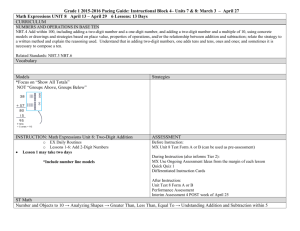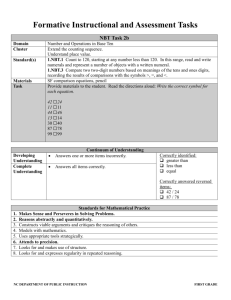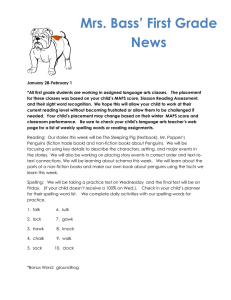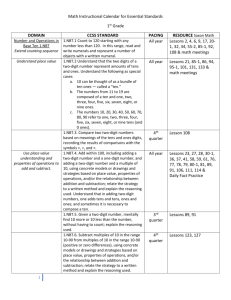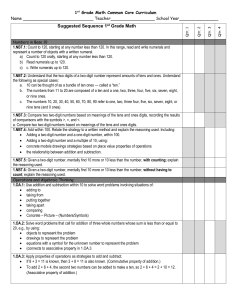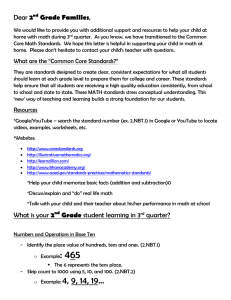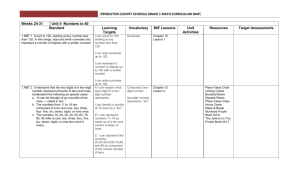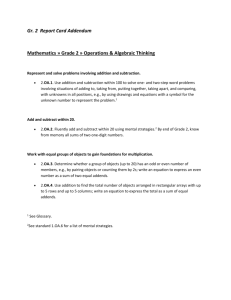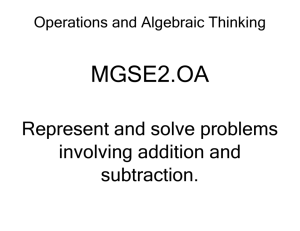Grade 1 Math Curriculum: Units 7 & 8 - Number & Operations
advertisement
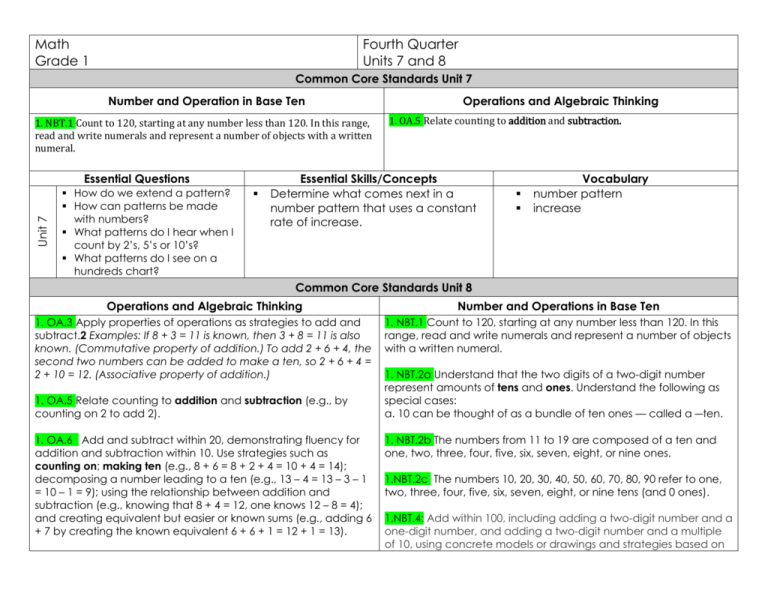
Math Grade 1 Fourth Quarter Units 7 and 8 Common Core Standards Unit 7 Number and Operation in Base Ten 1. NBT.1 Count to 120, starting at any number less than 120. In this range, read and write numerals and represent a number of objects with a written numeral. Unit 7 Essential Questions How do we extend a pattern? How can patterns be made with numbers? What patterns do I hear when I count by 2’s, 5’s or 10’s? What patterns do I see on a hundreds chart? Operations and Algebraic Thinking 1. OA.5 Relate counting to addition and subtraction. Essential Skills/Concepts Determine what comes next in a number pattern that uses a constant rate of increase. Vocabulary number pattern increase Common Core Standards Unit 8 Operations and Algebraic Thinking Number and Operations in Base Ten 1. OA.3 Apply properties of operations as strategies to add and subtract.2 Examples: If 8 + 3 = 11 is known, then 3 + 8 = 11 is also known. (Commutative property of addition.) To add 2 + 6 + 4, the second two numbers can be added to make a ten, so 2 + 6 + 4 = 2 + 10 = 12. (Associative property of addition.) 1. NBT.1 Count to 120, starting at any number less than 120. In this range, read and write numerals and represent a number of objects with a written numeral. 1. OA.5 Relate counting to addition and subtraction (e.g., by counting on 2 to add 2). 1. OA.6 Add and subtract within 20, demonstrating fluency for addition and subtraction within 10. Use strategies such as counting on; making ten (e.g., 8 + 6 = 8 + 2 + 4 = 10 + 4 = 14); decomposing a number leading to a ten (e.g., 13 – 4 = 13 – 3 – 1 = 10 – 1 = 9); using the relationship between addition and subtraction (e.g., knowing that 8 + 4 = 12, one knows 12 – 8 = 4); and creating equivalent but easier or known sums (e.g., adding 6 + 7 by creating the known equivalent 6 + 6 + 1 = 12 + 1 = 13). 1. NBT.2a Understand that the two digits of a two-digit number represent amounts of tens and ones. Understand the following as special cases: a. 10 can be thought of as a bundle of ten ones — called a ―ten. 1. NBT.2b The numbers from 11 to 19 are composed of a ten and one, two, three, four, five, six, seven, eight, or nine ones. 1.NBT.2c The numbers 10, 20, 30, 40, 50, 60, 70, 80, 90 refer to one, two, three, four, five, six, seven, eight, or nine tens (and 0 ones). 1.NBT.4: Add within 100, including adding a two-digit number and a one-digit number, and adding a two-digit number and a multiple of 10, using concrete models or drawings and strategies based on 1.OA.7 Understand the meaning of the equal sign, and determine if equations involving addition and subtraction are true or false. For example, which of the following equations are true and which are false? 6 = 6, 7 = 8 – 1, 5 + 2 = 2 + 5, 4 + 1 = 5 + 2. place value, properties of operations, and/or the relationship between addition and subtraction; relate the strategy to a written method and explain the reasoning used. Understand that in adding two-digit numbers, one adds tens and tens, ones and ones; and sometimes it is necessary to compose a ten. 1. OA.8 Determine the unknown whole number in an addition or subtraction equation relating three whole numbers. For example, determine the unknown number that makes the equation true in each of the equations 8 + ? = 11, 5 = _ – 3, 6 + 6 = _. 1.NBT.5: Given a two-digit number, mentally find 10 more or 10 less than the number, without having to count; explain the reasoning used 1.NBT.6 Subtract multiples of 10 in the range 10-90 from multiples of 10 in the range 10-90 (positive or zero differences), using concrete models or drawings and strategies based on place value, properties of operations, and/or the relationship between addition and subtraction; relate the strategy to a written method and explain the reasoning used. Unit 8 Essential Questions How can I use a 100 chart to help me count? How can we count from a variety of starting points? How can large quantities be counted efficiently? How can we represent numbers using ones and tens? How does using ten as a benchmark help us compose and decompose numbers? Essential Skills/Concepts Use counting on strategies to keep an accurate count of a set of objects. Rote count and record numbers to 120. Use skip counting as a strategy to solve problems about 2s, 4s, 5s, and 10s (eyes, hands, feet, fingers, etc.). Use an addition property to combine 2 numbers (6+6= 10 and 2 left over). Use tens and ones to solve 2 digit story problems. Add and subtract 10 to and from a given number. Vocabulary Counting on Addition equation Combine combination Less than Equals addend Same as
